Ottawa offers some great fishing. There’s a large variety of fish species that make their home in the cities waterways, many in the heart of downtown! If you’re interested in fishing in Ottawa, I’ve listed below all the commonly targeted species in the Ottawa area, in addition to some not-so-commonly targeted species that swim in our ponds, lakes, and rivers.
Most of the fish in the Ottawa region are warm or cool water species. Bass (both smallmouth and largemouth) are overwhelmingly the most popular species in the area. There are also many dedicated pike, musky, walleye, and catfish anglers in the region as well. Ottawa river species and Rideau river species make up the bulk of what I cover below. There are other small water bodies that offer good fishing opportunities as well.
This post uses amazon affiliate links. I receive commission from any sales at no additional cost to yourself.
Smallmouth Bass (SMB)
Micropterus dolomieu
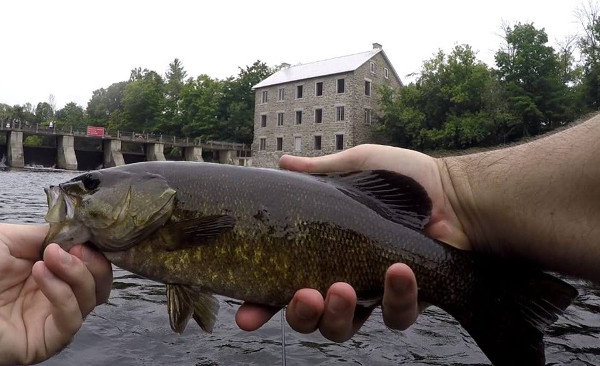
Smouthmouth bass are, without a doubt the most targeted fish species in Ottawa, and for good reason. They’re plentiful, eager to strike, and pound-for-pound one of the strongest fighting freshwater fish in the area (only carp give them a run for their money).
They can be found throughout both the Ottawa and Rideau rivers in large numbers. While there’s plenty of smallies around, the tricky part is finding a trophy bass, and there is no shortage of dinks in the area.
Look for rocky areas immediately adjacent to current. Outflows below dams, locks, below rapids and where a tributary enters a larger water body are examples of the type of water smallmouth bass will be drawn towards.
Plastic tubes, topwater, swimbaits, plugs and many other lures are all effective when targeting smallmouth. Crayfish (crawfish) are plentify in the area, and are on of the top forage species of smallmouth bass. Lures that mimic crayfish such as the Rebel Craw Lure (Amazon Link) and various soft plastics are very effective. The rocky stretches of the Rideau river seem to have more crayfish than some of the other surrounding rivers, so crayfish lures are especially effective there.
Smallmouth bass are also a great species to target for fly fishing in the area. They are be readily taken on many streamers and topwater patterns.
Largemouth Bass (LMB)
Micropterus salmoides
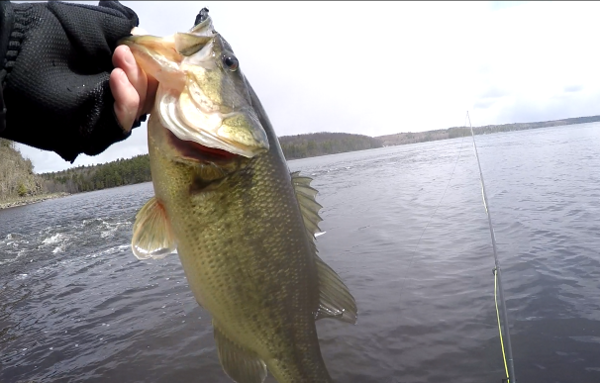
A close second in popularity is the largemouth bass. This is mainly because there are not quite as many largemouth bass here as there are smallmouth bass, although they are still quite common. Access to prime largemouth water typically requires a boat to access, although there are a few good shore spots along the Rideau River.
While largemouth bass and smallmouth bass can often be found in the same water, largemouth bass do tend to prefer calmer, weedier water. Look for calm weedy back bays, lakes, and ponds. Bigger largemouth bass will often hide in the heaviest weed growth, so don’t be afraid to cast right in the middle of the slop. Weedless lures and jigs are effective tackle when fishing in these conditions.
Largmouth bass are not limited to weedy back bays. They can be found throughout the Rideau river, and a pocket of slack water alongside some current could hold a largemouth just as easily as a smallmouth.
All the lures used to target smallmouth can also be used on largemouth, although you’ll have more success if you size up slightly. Skirted jigs, Senkos, and various topwater lures (like the classic jitterbug), are all very effective at targeting largemouth bass. There’s a very large selection of lures on the market for targeting largemouth bass (perhaps more so than any other fish species), as they eat a wide variety of prey items. There’s plenty of opportunities to play around with different plugs and jigs to see what works.
Pike
Esox lucius
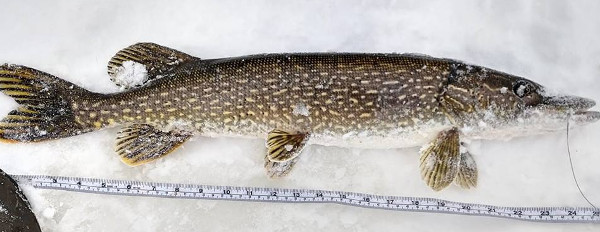
Pike are an exciting species of fish to target as the strikes are vicious and the fights violent. Expect a display of impressive acrobatics if you hook into one of these toothy critters. While they fight hard, the fight is usually quite short. Pike typically (there are exceptions) have one or two good runs in them before they tire out.
Pike are spread out throughout most of the waterways in the area. Unless it’s an isolated pond (and even sometimes then), there’s likely a pike sitting nearby. While pike, in general, are common, large pike are relatively rare in the Ottawa region (although not unheard of). While pike usually site near the top of the foodchain, that role in the Ottawa region is filled by Musky.
If you are specifically targeting pike the location depends on the time of year. They can be found in weedy back bays all year, but even more so in the spring. In the summer they disperse a bit. Many will remain along weedy edges, but more still (specifically the larger ones) will move to deeper water. In the fall they tend to move back in shallow until the cold of winter sets in.
Pike are often caught ice fishing in the area. They remain relatively active and feed regularly throughout the winter. If you are new to ice fishing, please read up on the risks and dangers associated with it before trying, and always bring a fishing buddy.
The fact that pike are toothy presents a problem. Their teeth will cut through mono and braided like butter. You need a bite proof (or resistant) leader if you’re going to be targeting pike.
The go-to has long been wire leaders. While bite-proof, some anglers claim the wire decreases strikes, especially in clear water. Flourocarbon leaders offer a less visible alternative in the 40lb+ range, with 60lb, 80lb, and even 100lb test being used to target pike. Flourocarbon leaders are highly bite-resistant, but not bite proof. The risk of a bite off still exists when using these (however slim).
Rapalas, swimbaits, and other lures mimicking baitfish are very productive. They will also eagerly go after topwater lures, and many soft-bodied frog lures have been lost to pike.
Musky (Muskellunge)
Esox masquinongy
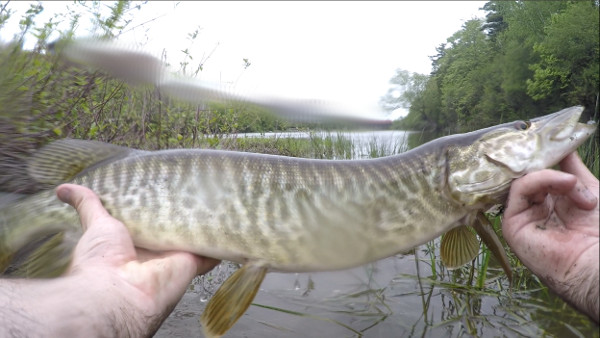
Musky are the largest members of the pike family, and grow very large in the Ottawa area. Ottawa river itself sees multiple 55″+ caught a year, the Rideau River is a close second with 40″+ fish not being uncommon, and 50″+ fish are not unheard of.
While not quite as far spread as pike, musky do very well in the Ottawa area. I’ve actually caught more musky than pike in certain waterbodies (specifically Ottawa River, Rideau River, and the Jock River). Typically when pike and musky inhabit the same waterway, pike out-compete musky (due to their fry hatching earlier and outgrowing musky fry), but the opposite situation seems to be true in and around Ottawa.
Musky are highly predatory and will prey on any fish (or creature) they can fit in their mouth. While they can be caught on smaller lures (many bass and walleye anglers accidentally hook into them), larger lures tend to produce better results. Lures such as the Bulldawg and Chaos Tackle’s The Posseidon Swim Bait (Amazon Link) are good tried and true musky lures.
Yellow Perch
Perca flavescens
Perch are another extremely common species of fish in the Ottawa area. They are a great fish species to target if you are fishing with kids, as they are very eager to bite.
Yellow perch are an important prey species in the area and relate heavily to structure for protection. Walleye in particular prey heavily on perch. The structure perch hide in can be emerging vegetation (such as cattails), a downed tree, or an old dock. They are commonly found in areas with little to no current but can be found in gently flowing rivers as well.
These fish are commonly targeted while ice fishing. Yellow perch is one of the better tasting fish in the area, but their flesh becomes riddled with worms in the heat of the summer. They tend to have less worms in the winter (depends on the specific water you’re fishing), so this is the best time to target them if you intend to eat your catch.
Channel Catfish
Ictalurus punctatus
Channel catfish are notable as they are not found in the Rideau River system, but are found in abundance throughout the Ottawa river. Channel catfish actually make up more biomass in the Ottawa river than any other fish species in the river. As such, it’s encouraged for those looking to retain fish to target the plentiful and delicious catfish that swim in our waters. Maybe we can give the poor walleye a break if more people start chasing catfish?
They can be found close to shore before the heat of the summer kicks in, but in the months of June, July and August are more often found in deeper water or near the cool water below dams. At night they’ll often come back in shallow to feed, even in warmer months.
They are often targeted with bait rigs that sit on the bottom. This is the most effective method of targeting them, although they will occasionally strike lures as well.
Brown Bullhead Catfish
Amerius nebulosus
These are a much smaller species of catfish than Channel Catfish. They are commonly targeted in the spring between ice-out and when the season opens for other more popular species. A basic bait rig that sits on the bottom works well. If you know the depth well enough to float the bait just above the bottom, a float rig (similar to a trout float rig) can also work.
One tip I will give new anglers regarding bullheads is to watch out for their spines! They have spines on their two pectoral fins and dorsal fin. These hurt when stung so handle with care.
Walleye
Stizostedion vitreum

Also commonly called pickerel in Ontario, these fish are one of the most popular sport fish in the province. They are heavily targeted and retained in the area (due primarily to being fantastic table fare). This means theres less of them in the area, and they tend to be smaller than in some other regions. You can still track them down though, it just might involve hooking into a few smallmouth bass along the way to find them. I think that’s an okay problem to have.
Try below dams and below/beside rapids. Walleye’s large eyes (for which they are named) also make them quite sensitive to light. You will have better luck targeting these fish at dusk, dawn, and night. Rainy and heavily overcast days also makes for good walleye fishing.
Walleye are also commonly targeted while ice fishing in the area. Find the other ice fishing shacks and you’ll find the fish.
When handling walleye, be careful of their many sharp teeth. They do not actually require a bite-proof leader though. Their teeth are just pointy, they don’t slice line like pike or musky teeth do.
Sauger (a close relative of Walleye) are also present in the Ottawa region. They’re not typically found in the Rideau river, but can be caught in the Ottawa river. Ice fishing is typically the best way to target Sauger in Ottawa.
A note on sauger. There is a more robust population of Sauger present in the Ottawa River as you travel several hours upstream from Ottawa. Down here around the actual city of Ottawa, they’re more sparse.
Black Crappie
Pomoxis nigromaculatus
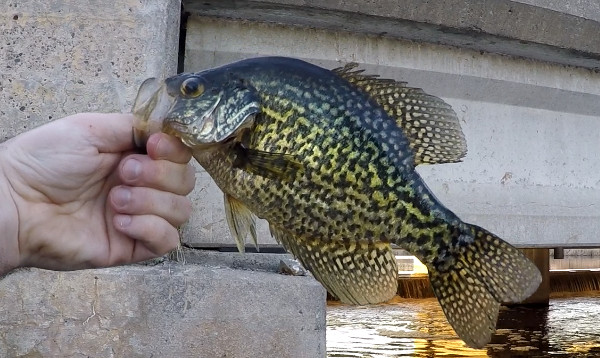
The best fishing for black crappie is in the spring. They stack up in large schools pre-spawn, and slowly disperse from the spawning site post spawn. They are most easily targeted before they disperse again. They are drawn to warmer water in the spring. Calm back bays and under spillways are prime spots to find spring crappie in the Ottawa area.
Throughout the rest of the year they can be hard to find, but try heavy vegetation, downed logs/trees, and other similar structure.
Crappie are another species that are targeted in the winter. In contrast to yellow perch, they are often suspended in the middle of the water column, occasionally only a few feet below the ice. It’s important then to search vertically throughout the water coloumn, buy bouncing your jig at different depths. Work a hole thoroughly before drilling a new hole.
Carp
Cyprinus carpio
Carp are present in large numbers in the Rideau, and it’s common to see large shoals of carp cruising around right downtown Ottawa. There are many fish in the 5-15 pound range, but they can get up to 50 pounds in the Rideau.
These are the strongest fighting fish (with the possible exception of a big channel catfish) in the area. When you hook into a carp, they often take off like a freight train. If you’re going to tackle these fish, make sure you have stout gear!
In late April/Early May they are getting ready to spawn. It’s difficult to target them at this time (possible, but they generally only have one thing on their minds), but they put on quite a display this time of year. You can see them splashing around and very large carp will jump and clear the water.
For any trout fly anglers that have moved to the city, and are dismayed at the lack of trout, try carp on the fly. They are wary, smart, and fight hard, all the makings of a good sport fish. They will take many larger trout nymph patterns (and even dries if the conditions are right). Although for the best chance at success you’re best bet is to use specific carp flies.
Sunfish (Pumpkinseed & Bluegill)
Lepomis gibbosus, Lepomis macrochirus
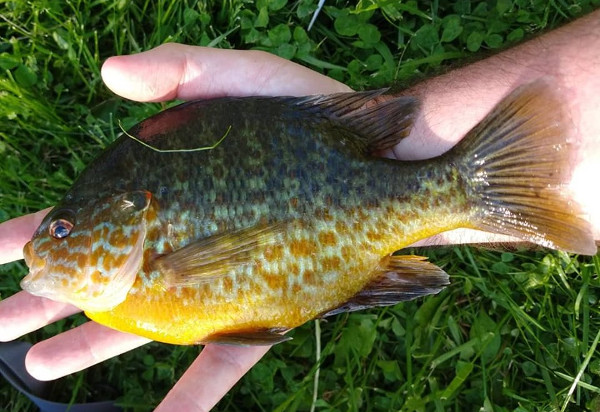
The term sunfish includes a large variety of different fish species. Sun fish can often be found alongside yellow perch, but relate even more strongly to cover. Weed beds, overhanging bushes or trees, and docks are common types of structure in which sunfish take shelter.
Sunfish are another great species to target for new anglers, as they are also very eager to take anything presented to them. Small soft plastics and flies work very well for these fish.
Longnose Gar
Lepisosteus oculatus
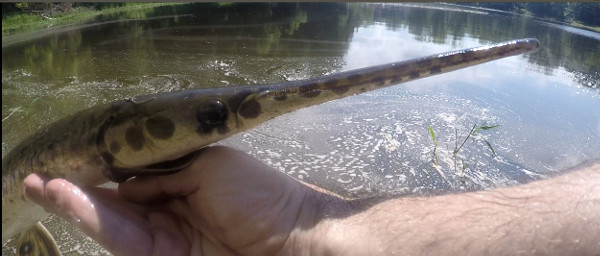
These are fish that seem like they belong in a tropical rainforest, not Canada’s capital. Thin, covered in thick scales, with a long snout full of sharp teeth, they seem almost prehistoric.
Longnose gar spends most of their times in calmer areas on the Ottawa river. Look for gar in calm inlets, and around the downstream/calm side of islands. The ancient fish can often be seen “sunning” themselves at the surface. They often hang out at the surface or just below it, snapping at baitfish that swim by.
You need very fine wire hooks to successfully penetrate their bony mouths. A small, shallow running Rapala X-Rap (Amazon Link) works very well for targeting these toothy fish.
You won’t find them in the Rideau at all, but they can be found throughout the Ottawa river and into its tributaries.
Check out this post for more information on fly fishing for longnose gar.
Brown Trout
Salmo trutta
Shhh, they’re not native so you’ll only find stocked populations. I can’t (won’t) tell you specific spots, but they do exist in the Ottawa area. I will say that they most certainly are not found in the Rideau River.
I’ve had good luck targeting trout both with soft plastics and of course by fly fishing.
That being said, if you’ve moved to the city and are a trout angler, cold water species are few and far in between in the area. Lake Ontario tributaries, Algonquin Park, Quebec, and upstate New York offer the closest productive trout water to Ottawa. This refers to brookies, browns, and rainbow trout.
Freshwater Drum
Aplodinotus grunniens
Also known as sheepshead, these often overlooked fish are very strong fighters, no surprise when you realize they’re related to Redfish (a popular saltwater species down south). They are commonly found around the mouths of tributaries, usually in slower stretches of the river. This includes both flats and deeper holes adjacent to the current.
They can be caught on traditional bass and walleye gear. For the best chance of success, try bouching a soft plastic tipped jig along the bottom.
Redhorse’s
Moxostoma carinatum, Moxostoma macrolepidotum, Moxostoma anisurum, Moxostoma valenciennesi
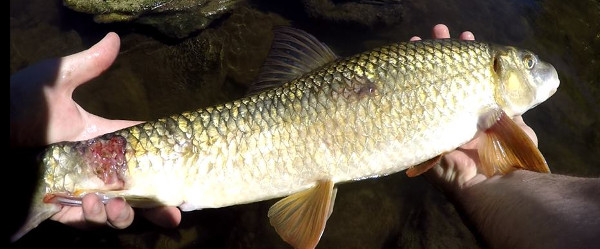
Very strong fighters, these fish take off like a freight train when hooked. I target them using small crayfish flies twitched along the bottom near where they are feeding. They can also be targeted with a bait rig that sits on the bottom or jigheads rigged with soft plastics.
There are actually four species of redhorse in the Ottawa Valley. Greater Redhorse, River Redhorse, Shorthead Redhorse, and Silver Redhorse. Aside from varying in size, appearance, and some slight differences in preferred habitat, they are quite similar. The same techniques can be used to target all species.
Fallfish
Semotilus corporalis
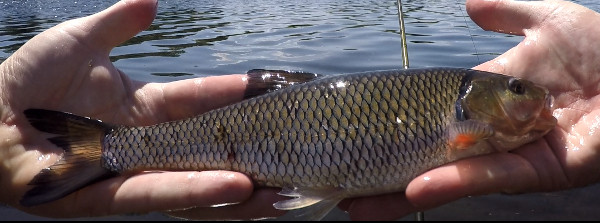
When I moved here from the east coast, this is actually the first fish I caught in an Ontario river. I caught it using the same streamer swinging techniques that I would use for targeting brook trout in mid-sized streams on the east coast.
They’re fond of current and are often found in rocky riffles. As mentioned above, If you’re fly fishing they’ll eagerly strike a streamer swung through the current. Small soft plastics on panfish sized jigs will work well if you’re targeting fallfish with lures.
They’re commonly used a bait by musky and pike anglers, and are quite effective.
Mooneye
hiodon tergisus
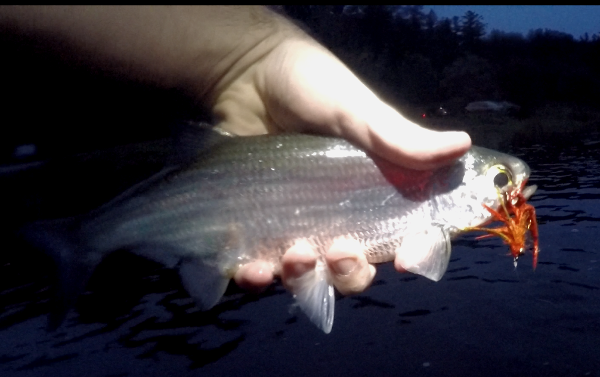
Mooneye are hyper active fish that superficially resemble shad. Shad and Mooneye are not at all related tough, they just evolved similar body plans to fill a similar niche.
The name of this fish is a bit of a giveaway as to when it’s most active. These fish have oversized eyes that allow them to feed in low light conditions. They are most active right before dawn or right after dusk, but will feed throughout the night.
Mooneye have very small mouths, and feed on smaller prey than you might expect for a fish its size. They can commonly be seen feeding on shad flies in the back bays of Ottawa river.
This is good news for the dry fly enthusiast looking to scratch that itch while trout are in short supply. Mooneye take dry flies readily, but will also take streamers & wet flies.
Suckers (Common White Sucker & Longnose Sucker)
Catostomus commersoni, Catostomus catostomus
Bottom feeders, these fish can be caught using the same method carp anglers use.
Many anglers target suckers during their spring spawning run, when they can be found in rocky clear streams. They are used as pike and musky bait by many anglers and are typically larger than fallfish.
Rock Bass
Ambloplites rupestris
Rock bass are very common along rocky shorelines. They are very eager to strike anything that fits in their mouth. A good species to target if you have kids with you as they are easy to catch and plentiful. You will likely catch these incidentally when targeting perch, sunfish, or other bass species.
Burbot
lota lota
You don’t hear many folks catching burbot around Ottawa in the regular fishing season. It’s not until ice fishing hits that you can expect to target these with any consistency. My understanding is burbot are restricted to the Ottawa River in the region.
It’s the only freshwater cod-like fish. Their preferred habitat is large, deep pools in rivers or lakes. In the winter, they come in shallow (relatively) and are more easily targeted by ice fishing.
Quillback
Carpoides cyprinus
Not many anglers have seen or even heard of these fish, but I think that might have to do more with how difficult they are to catch rather than an indication that they might be rare.
They feed on small aquatic insects and vegetation off the bottom. In addition to this they bite very lightly (sight fishing may help here) and are easily spooked. A worthy target for the sports angler looking to test their skill.
Commonly found in calm stretches of river, look for the same type of water you would find carp in and you’ll have the best odds of coming across these fish.
Micro Fishing
There’s a large number of minnow, shiner, darter, and other various tiny species of fish in the area. If you’re into micro fishing there’s plenty of opportunities here.

Cool list. Missing sturgeon. 😉
Purposely left sturgeon off the list actually. They’re the biggest fish in the Ottawa river, but it’s not legal to fish for them.
This list was just about what species you can fish for, so sturgeon was left out.
Yellow Bullhead can be found inthe right spots
Rock bass can be found anywhere.
Sauger is a common fish during ice fishing.
You’re absolutely right!
Yellow Bullhead – I’ve only heard reports, but not caught one myself, so left it out. I should atleast mention them as possibilities though!
Rockbass – These are listed, it’s just near the bottom of the post.
Sauger – Legitimately forgot! Which is a shame cause I chase walleye more than anything else now. This probably makes it obvious that I fish the Rideau River more than the Ottawa River.